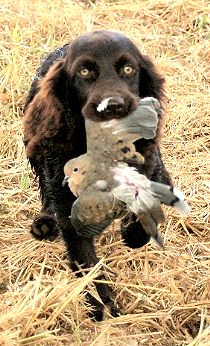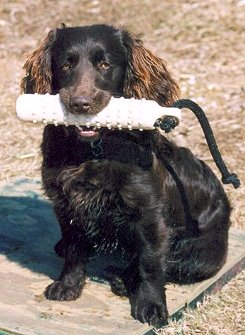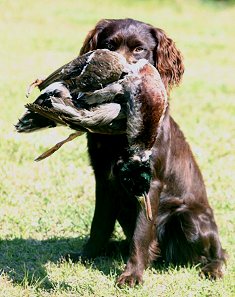  Nothing is more aggravating to the perfectionist hunter-dog handler than having a dog drop his birds in the field. Most hunters are happy if pup will go out and fetch his birds and bring them within a few feet before dropping them.
Personally, I feel that the finished retriever delivers his birds to hand. That means he sits and holds his bird until I ask him to drop it in my hand. One other advantage is if the bird is crippled and the pup brings it to hand, the bird wonít fly off and be lost.
Ninety percent of the time, dogs who drop their birds have been inadvertently conditioned by their owners. The owner either didnít care if pup dropped his bumpers or possibly grabbed at pup to keep him from dropping bumper which caused pup to drop his bumper.
The easiest way to teach pup to hold his birds is to condition pup never to drop them in the first place. When you bring pup home and are playing hallway retrieves, let him parade and carry his sock dummy. Put one hand on his chest to stop forward motion and with the other gently push his rump down. The whole time pup has a death grip on his dummy. If he drops it, donít worry. The key here is to teach pup to sit when he delivers his bird. Donít grab at the dummy or you will teach pup to play keep-away or to clamp down on his birds. When pup is sitting, gently pry his mouth open and take the dummy, saying, "drop".
The same thing goes out in the yard. With pup on a check cord, toss a bumper or a bird. If pup doesnít come straight back to you, reel him in, letting him hold his prize. Push his rump down and make him sit. Then, gently pry his mouth open and tell him to drop.
Okay, thatís all well and good with a new pup. What if you have an older dog that hasnít been conditioned to hold? You start over and teach him. If you donít have a bench to work pup, then sit down on a stool or bucket and have pup sit in front of you, on leash. Step on the leash or check cord so pup canít run off. Put a heavy leather work glove on one hand. Open pupsí mouth and place your gloved hand in his mouth. Gently place your thumb on his lower jaw so he canít spit out your hand. Talk sweet to him and let him know itís okay. Some dogs throw fits. If yours is one of them, contain pup the best you can without hurting him. Sometimes it helps to grab pup by the scruff of the neck. That pulling tightens the muscles in his mouth as well as reminds him whoís boss. When he settles down and accepts your hand, say, "good hold" then ďdropĒ and remove your hand. Repeat until pup will readily accept your hand resting in his mouth.
"Keep a positive attitude, keep the lessons short and soon youíll have pup delivering to hand."
When pup will hold your gloved hand, have some Ĺ or ĺ inch PVC pipe cut into one-foot lengths. Stick several in your pocket. Place one in pupsí mouth. Be ready for him to spit it out - and be just as ready to grab another to take its place. When pup has the pipe in his mouth, tell him "good hold". When he spits it out, tell him, "agh!" put another pipe in his mouth and softly rap him on the lower jaw to keep his mouth closed. If pup chomps on the PVC, tell him "no" and hold his mouth closed. A lot of your success will depend on how quick you are in catching pup before he drops whatever is in his mouth. Watch pup closely and if he moves a muscle, tell him "no", softly rap him on the chin and remind him to hold.
Take your time. For example, lesson one is to hold your gloved hand. Lesson two - to however many tries it takes - is to hold the PVC pipe. If you can get pup to hold the pipe and sit for two seconds, end the lesson there. Next lesson, have pup hold the pipe for five seconds. On the next lesson, have the pup hold - and you step away from him. If he spits the pipe out, put it back in his mouth and try again. These lessons can take several weeks so donít rush it. Keep pup tail-wagging happy as much as possible.
When pup will sit and hold the pipe, itís time to get pup moving. This is easier on your back if pup is elevated. While pup is holding his PVC pipe, cup his lower jaw and encourage pup to walk without dropping it. If he spits it out, put it back into pup's mouth and try again. What you are aiming for is getting pup to hold, carry and sitting to deliver his pipe. The main focus here is holding so you may have to encourage pup to walk and push his rump down for sits. Donít worry about anything except pup holding what is in his mouth.
When pup will hold and carry the PVC pipe, itís time to move to a wooden dowel or dog dumbbell - like the ones they use in obedience. The reason we are using non-retrieve items is so that you get any negative training done without pup associating it with birds. Once pup understands the concept, then you will teach pup to hold anything that he carries. When pup will hold and carry the dumbbell, move on to a small plastic, empty soda bottle. When pup will carry the bottle, alternate between the three items until pup will carry anything you offer him. Now itís time to have pup hold and carry a bumper.
The last thing you want is for pup to relate the bumper (and later his birds) to negative feelings. Thatís why youíve done the preliminary work with non-retrieving articles. When you place the bumper in pup's mouth he should accept it readily. If he spits it out, talk sweet to him and put it back in his mouth. Gradually get pup to hold and sit with the bumper.
Put a check cord on pup. Walk away from pup while he is holding his bumper, walk circles around pup, then walk back and take the bumper from him. Put the bumper back in pup's mouth and walk away. Holding the check cord, call pup to you with your hand ready to stop him from dropping the bumper. If he wants to drop the bumper, hold your hand under his chin and coax him to walk toward you. When you get pup to carry the bumper a few feet without dropping it and sitting to deliver, quit for the lesson. Next time out, start at the same lesson and as pup progresses, get him to hold and carry at heel. Every time he drops the bumper, put it back in his mouth and command the "hold".
"If he drops it a few feet away, stop and think about what the dog is doing. Some dogs are intimidated by their owners."
When pup will hold and carry the bumper, the next step is to toss it a few feet. Cast pup to fetch it up and encourage him to bring it in, telling him to Ďholdí and praising him if he does.
If he drops it a few feet away, stop and think about what the dog is doing. Some dogs are intimidated by their owners. If this is the case, try turning your back on pup and squat down so that you are less menacing. Not making direct eye contact, encourages the softer pup to come in closer. As pup is returning with his bumper, turn and walk away. Stop with your back to pup and squat down to take the bumper. Talk sweet to pup and praise the heck out of him when he does a good job. Once pup understands you wonít Ďbiteí he should deliver with you facing him. Donít force it or rush it.
The last step is to have pup hold and carry birds. I find it easiest to start this part of the lesson with pup fetching a thrown bird. When he comes in encourage the Ďholdí and if he drops it, gently open his mouth and tell him to "fetch". This part has to be handled correctly so that you donít relate anything bad with birds. It is essential during this part of his training that you donít lose your temper. If pup drops the bird, kick it with your foot and encourage pup to fetch it up. Bend over and cup your hand under his chin while calling pup in and have him sit.
Keep repeating these lessons until pup will hold and carry anything you ask him to. Keep the lessons short, though, so that pup sees this as fun rather than a chore.
One other trick to try is to add some competition. Either tie out your pup on a chain or have a buddy come out to train with his dog. If your pup is reluctant, have your friend work his dog right next to you. Your friend's dog should be delivering to hand to set a good example. Often, just the idea of another dog getting your pup's birds is enough to finish the job.
Most hunting retrievers that have a strong drive to retrieve will only need to be conditioned to hold. Keep a positive attitude, keep the lessons short and soon youíll have pup delivering to hand. If this doesnít work, the next step is the conditioned retrieve (force-fetch) which is a whole other topic to be addressed in future issue.
Happy training.
Pam
Part Two The Conditioned Retrieve: Force Fetch

|
|
|
| Bookstore | The Bookshelf | Advertise on SJ | Classifieds | Resources | NEW! Events | Letters | Archives | Spaniel Journal | |



